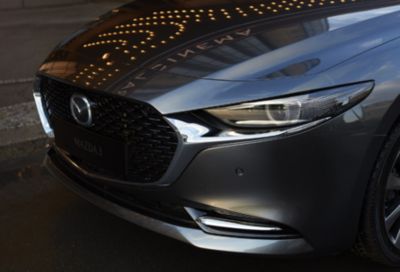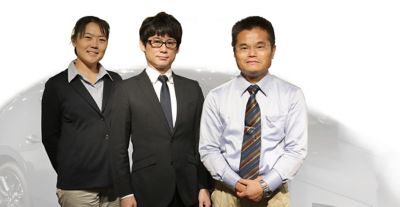-
-
Access Free Student Software
Ansys empowers the next generation of engineers
Students get free access to world-class simulation software.
-
Connect with Ansys Now!
Design your future
Connect with Ansys to explore how simulation can power your next breakthrough.
Countries & Regions
Free Trials
Products & Services
Learn
About
Back
Products & Services
Back
Learn
Ansys empowers the next generation of engineers
Students get free access to world-class simulation software.
Back
About
Design your future
Connect with Ansys to explore how simulation can power your next breakthrough.
Free Trials
ANSYS ADVANTAGE MAGAZINE
DATE: 2020
Mazda Sees the Light with Ansys Speos
By Ansys Advantage Staff
Mazda Motor Corporation marked the 100th anniversary of its founding on Jan. 30, 2020. Since 2010, the company’s cars have been developed using its vehicle optimization platform, SKYACTIV, which includes many new technologies. The company has aggressively invested in computer-aided engineering (CAE) to efficiently develop SKYACTIV. Ansys Speos 3D optical analysis software played an important role in the development of the interiors and lights of the MAZDA3, which launched in 2019 as the first model of its new generation of vehicles.
ANSYS Speos PROVIDES ACCURATE AUTOMOBILE LIGHTING EVALUATION
In automobile lighting technology, design degrees of freedom have greatly improved since transitioning to LEDs. Before this transition, light illumination and performance was determined to some extent based on the knowledge of the supplier. The supplier would propose a new light using various tools. However, Mazda had no idea how to independently judge the recommendations or perform illumination analysis. Mazda also had to ensure that it was satisfying various legal regulations and functionality requirements. To move forward, Mazda needed to evaluate the actual light illumination early in the development cycle.
“In other development fields, such as collision safety and vibration noise, we used simulation-based performance verification and model-based development in the design stage,” says Minoru Inoue, technical leader in Mazda’s Interior & Exterior Components Technology Development group. “Meanwhile, in the development of interior and exterior equipment, including lights, verification was mostly conducted using an actual vehicle, so we knew that we were far behind in the optical development. That is why we always wanted to evaluate the human senses, such as feeling comfortable and looking good, based on the physical quantity to front-load the development.”
“We also liked Ansys Speos because its simulation allows us to evaluate different physical quantities — luminance required in the visual lighting evaluation and luminous intensity required to satisfy the legal and regulatory check — at the same time in a single analysis,” adds Yoshiaki Nakaya, assistant manager in Mazda’s Exterior Components Development group.
“Mazda is still backing model-based development, but we recommend proceeding with development after understanding the mechanism [principle or basis] of part design — even if it is conducted by the supplier,” says Inoue. “I prepared a document and explained to people within our organization that this tool teaches us technologies and leads to efficient development. I successfully convinced them.”
Before the implementation of Speos, Mazda prototyped a principle model concept multiple times before beginning a detailed design after a development direction was set. Then, Mazda engineers made another prototype and finally created the actual vehicle model using the final design data. Consequently, Mazda spent a lot of money on repeated prototyping. It cost a few to 10 million yen (about $95,000) to create each molding die of a lamp, for example.
With Speos, the company successfully reduced the number of prototypes it needed. On average, Mazda is able to remove two or three prototypes from its production process because Speos allows engineers to find and correct issues in the design.
“For example, a light leak that ends up illuminating outside the area you want to illuminate is difficult to find in computer-aided design (CAD) data, and even an experienced engineer sometimes overlooks it,” says Nakaya. “In an Ansys Speos simulation, however, we can check such an error from different angles. There is now almost no leak, resulting in less rework.”
Ansys Speos was used for interior and exterior lighting simulation at Mazda Motor Corporation. The company’s use of model-based development results in fewer prototypes, saving time and lowering costs. Speos also provided a means to quantify the user experience, which justified engineering change orders and improved workflow efficiency.
QUANTIFY HUMAN SENSES FOR AN OPTIMAL USER EXPERIENCE
The Mazda Vehicle Testing & Research Department carries out both experiments and research, while the Craftsmanship Development Group studies the human body, senses, recognition and expressions to account for details such as the visibility and texture of display equipment.
Asami Yonezawa, senior specialist in Mazda’s Craftsmanship Development group, oversaw antiglare development when Speos was introduced. Her group chose Speos because of a sun glare problem. Sunlight reflected off the silver plating around the center louver in some models, which caused glare while driving. Fixing the problem required the shape of the plated parts to be changed, resulting in about 10 million yen in additional costs to modify the mold. The same symptom was also found in other models, so the group had to take some measures even before modifying the mold.
Veteran engineers reshaped the plated parts based on their experience, so there was no quantified data to show how much light is dazzling to the human eye. Even specialists who evaluated the glare, such as Yonezawa, only visually checked but could not quantify it. The company wanted a way to measure the glare.
Speos met all three evaluation criteria set by Mazda:
- Accurately analyze light amount and wavelength
- Accurately analyze reflectance properties
- Reproduce and quantify luminance distribution in two dimensions
“Our conventional tool converted 3D data created by the design styling and design divisions into another file, so when we made a mesh, it resulted in degraded accuracy,” says Yonezawa. “Because Ansys Speos allows us to use our 3D CAD product as an add-on, we can perform a simulation without sacrificing the accuracy. This is one of the key aspects we liked.”
Yonezawa’s group was also working on another issue: The reflection of in-vehicle parts on the inside of the windshield made it difficult for drivers to see through the windshield. Being unable to show the design issues quantitatively, Yonezawa had difficulty making the designer understand the necessity of an improvement. However, Speos allows quantitative illumination analysis, which she could use to ask the designer for improvements.
The group proactively used Speos to design the lights and interiors in the MAZDA3. In test drives for journalists held worldwide when announcing the launch, the drivers noted that the MAZDA3 had clear views.
From left: Asami Yonezawa, Yoshiaki Nakaya and Minoru Inoue implemented Ansys Speos for interior and exterior lighting simulation at Mazda Motor Corporation.
MORE EFFICIENT SUPPLIER RELATIONS
Since the introduction of Speos, Mazda has seen changes in business relationships with its suppliers. In the past, Mazda used a one-way development process for lights. For example, the company would provide a design concept and a lighting image to the supplier so they could make a proposal based on their knowledge. Today, Mazda is not involved in detailed design but performs a simulation and makes its own proposal to the supplier.
“What makes it different from the traditional development style is that we can prepare a concept in a stage where an area around the light has not yet been designed, which leads to cost optimization,” says Nakaya. For example, Mazda engineers can use simulation to optimize an automobile lighting mount design for mass production, which saves time and money.
The supplier also seems to like this change to their relationship because determining the specifications in the early stages and preparing the optimum design on both sides can lead to more efficient development. Mazda is now adopting a development process to quickly determine the specifications by sharing the same perspectives in real time between the engineers and the supplier as they simulate with Speos together.
Not only does Speos improve communication between Mazda and its supplier, but communication between the design and the development divisions inside the company has improved as well.
“It was always difficult to verbally explain how much more the vehicle can improve, but visualizing it with Ansys Speos easily convinces the designer,” says Yonezawa. “Once satisfied, the designer is willing to accept the design change. This can be achieved even without making an actual product, which is one of the great advantages.”
Let’s Get Started
If you're facing engineering challenges, our team is here to assist. With a wealth of experience and a commitment to innovation, we invite you to reach out to us. Let's collaborate to turn your engineering obstacles into opportunities for growth and success. Contact us today to start the conversation.


